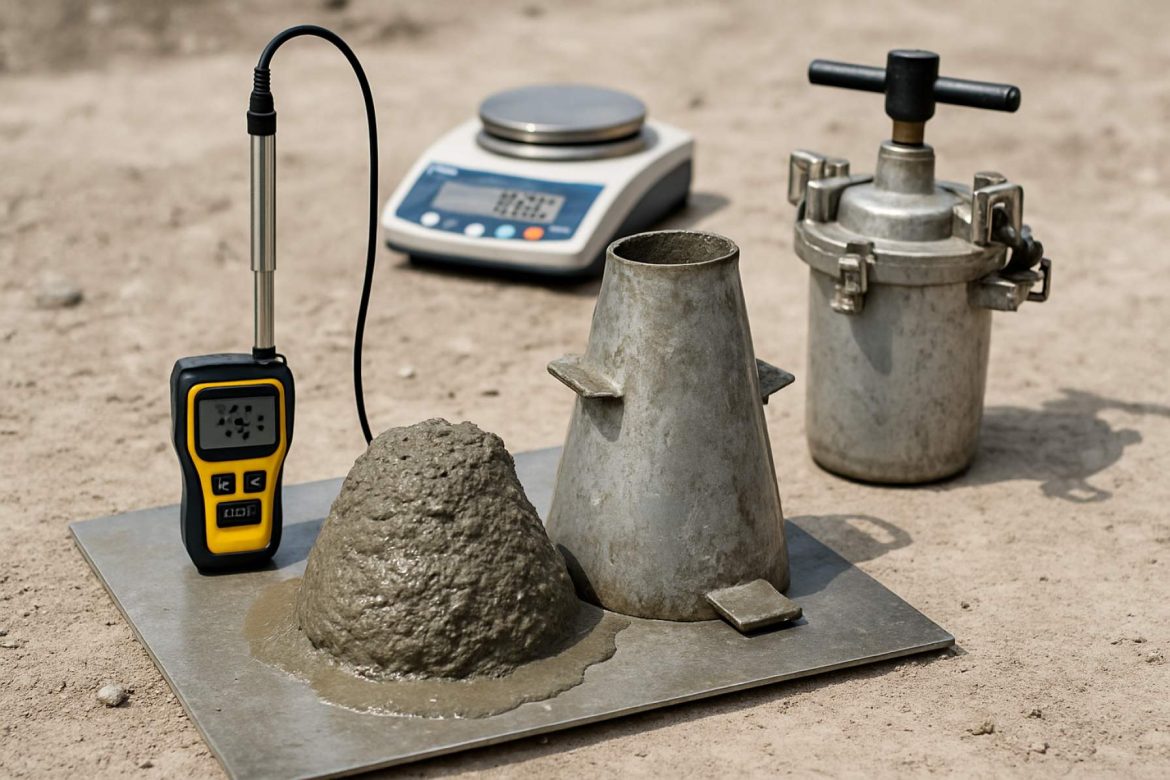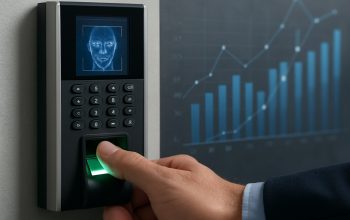Table of Contents
- Executive Summary: Key Trends in Wet Concrete Testing Instrumentation (2025–2030)
- Market Size & Forecast: Growth Projections and Drivers for 2025–2028
- Technological Breakthroughs: Next-Gen Sensors and Real-Time Analytics
- Major Players & Competitive Landscape (Based on Official Manufacturer Sources)
- Regulatory Environment and Standards: Compliance Updates from Industry Bodies
- End-User Segments: Construction, Infrastructure, and Beyond
- Smart Instrumentation: Integration with IoT and Digital Platforms
- Sustainability and Green Building Impacts on Testing Protocols
- Challenges & Opportunities: Supply Chain, Training, and Adoption Hurdles
- Future Outlook: Innovations and Disruptions Shaping Wet Concrete Testing by 2030
- Sources & References
Executive Summary: Key Trends in Wet Concrete Testing Instrumentation (2025–2030)
The wet concrete testing instrumentation sector is undergoing significant transformation in 2025, driven by advances in sensor technologies, automation, and increasing regulatory focus on construction quality and sustainability. The global construction industry’s emphasis on durability and compliance is spurring adoption of advanced testing equipment for slump, air content, temperature, and setting time. Major manufacturers and industry organizations are steering the shift toward digital, real-time data collection and remote monitoring, which is expected to define sector trends through 2030.
- Digitalization and Automation: Modern wet concrete testing is rapidly moving away from manual methods. Companies like CONTROLS Group and Humboldt Mfg. Co. are introducing automated slump testers, wireless sensors, and app-based data logging, improving both accuracy and traceability. In 2025, the use of IoT-enabled devices for continuous monitoring of temperature and humidity in fresh concrete is gaining traction on job sites and in precast plants.
- Enhanced Data Integration: Instrumentation now frequently incorporates cloud connectivity, allowing seamless integration with construction management platforms. Giatec Scientific has expanded its SmartRock wireless sensor platform, enabling real-time strength and temperature monitoring for in-situ concrete, with data accessible via mobile devices and BIM software.
- Focus on Sustainability and Compliance: Regulatory bodies such as the ASTM International and British Cement Association are updating standards, encouraging the use of instrumentation that can verify sustainable mix designs and support environmental reporting. Carbon footprint monitoring and mix optimization are poised to become standard features in next-generation devices.
- Market Outlook 2025–2030: The next five years are expected to see further integration of AI-driven analytics in testing instrumentation, enhancing predictive maintenance and quality control. Companies are investing in portable, ruggedized instruments suited for remote and challenging environments, as seen in new product lines from ELE International and MTM Instruments. Growing infrastructure investment in Asia, the Middle East, and North America is anticipated to accelerate market growth and drive demand for advanced testing solutions.
In summary, the wet concrete testing instrumentation landscape in 2025 is characterized by rapid technological innovation, greater connectivity, and alignment with global sustainability and quality initiatives. These trends are set to intensify, shaping the sector’s evolution through 2030.
Market Size & Forecast: Growth Projections and Drivers for 2025–2028
The global market for wet concrete testing instrumentation is poised for sustained growth from 2025 through 2028, propelled by ongoing investments in infrastructure, tightening quality standards, and the integration of digital technologies in construction quality control. Key market drivers include the acceleration of smart city projects, stricter regulatory oversight on construction materials, and the adoption of advanced testing protocols to ensure structural safety and longevity.
Recent statements from industry leaders indicate robust demand. For example, Controls Group, a global manufacturer of construction testing equipment, highlights continued expansion in both developed and emerging markets as municipalities and private developers prioritize infrastructure resilience. Similarly, Humboldt Mfg. Co. and Germann Instruments report increased orders for automated slump testers, air content meters, and temperature sensors, reflecting a broader shift towards digital and real-time data collection.
Data from National Ready Mixed Concrete Association (NRMCA) underscores rising concrete consumption, particularly in North America, where large-scale public works and urban redevelopment foster the need for rigorous wet concrete testing. The trend is mirrored in Europe and Asia-Pacific, where regulatory agencies enforce EN and ISO standards, pushing contractors to adopt advanced testing instrumentation to maintain compliance and avoid costly rework.
In terms of market size, leading industry suppliers forecast high single-digit compound annual growth rates (CAGR) for wet concrete testing instruments through 2028. While precise figures are proprietary, Mecmesin and Matest both cite infrastructure modernization and the transition to Industry 4.0 as catalysts for higher instrumentation spend. This includes not only traditional tools like slump cones and penetration needles, but also wireless sensors, cloud-connected data loggers, and integrated quality management platforms.
Looking ahead, the market outlook remains positive as construction firms prioritize automation and predictive analytics to minimize downtime and optimize material usage. The integration of Internet of Things (IoT) devices—such as those offered by Giatec Scientific—is expected to accelerate, enabling real-time monitoring of concrete properties directly on job sites. As a result, demand for sophisticated wet concrete testing instrumentation is set to expand, supporting the ongoing evolution of global construction standards and practices.
Technological Breakthroughs: Next-Gen Sensors and Real-Time Analytics
The field of wet concrete testing instrumentation is undergoing significant transformation in 2025, driven by advancements in next-generation sensors and real-time analytics. These innovations are enabling more accurate, faster, and data-rich quality control, which is essential for modern construction practices, including those utilizing high-performance and sustainable concrete mixes.
One of the major breakthroughs is the widespread adoption of wireless and embedded sensor systems. Companies like Giatec Scientific Inc. have developed compact, smart sensors such as the SmartRock device, which can be placed directly inside concrete pours to monitor temperature, maturity, and strength development in real time via mobile applications. In 2025, these sensors are increasingly being integrated with cloud-based platforms, enabling remote monitoring and predictive analytics for concrete curing and quality assurance.
Another advancement is the move towards non-destructive and continuous measurement technologies. Controls Group has introduced advanced ultrasonic pulse velocity and wireless maturity meter systems, which provide instant, accurate data on concrete properties without the need for intrusive sampling. Similarly, Humboldt Mfg. Co. is offering wireless data loggers and on-site testing devices compatible with modern construction management software, streamlining compliance and documentation processes.
Artificial intelligence (AI) and machine learning are also playing a growing role in wet concrete testing. Sensor data streams are now being processed by AI algorithms to predict optimal curing times, detect anomalies, and recommend adjustments to mix designs. This is evident in the offerings of Sika AG, which is investing in digital platforms that combine sensor data with AI-powered analytics for real-time decision support.
The trend is toward greater interoperability and standardization, with leading manufacturers aligning their instruments to work seamlessly with Building Information Modeling (BIM) systems and other digital construction tools. The collaboration between sensor providers and construction software companies is expected to intensify over the next few years, resulting in holistic digital quality management ecosystems.
Looking ahead, the outlook for wet concrete testing instrumentation is defined by the convergence of smart sensors, wireless connectivity, and advanced analytics. Continuous improvements in sensor sensitivity, battery life, and data integration capabilities are anticipated. These developments promise not only enhanced quality control but also greater sustainability and productivity across the concrete construction sector.
Major Players & Competitive Landscape (Based on Official Manufacturer Sources)
The wet concrete testing instrumentation sector is characterized by a handful of established global manufacturers alongside innovative niche players, each vying to address the evolving demands of the construction and infrastructure industries. As of 2025, the market landscape is shaped by the drive for greater automation, real-time data collection, and enhanced accuracy to comply with ever-stringent quality standards.
Key multinational players include CONTROLS Group, Humboldt Mfg. Co., and Germann Instruments. These companies offer comprehensive portfolios encompassing traditional slump cones, air content meters, and concrete penetrometers, as well as advanced digital and wireless solutions. For example, CONTROLS Group’s range includes both manual and automated equipment for slump, flow, and fresh density tests, addressing laboratory and field requirements. Humboldt Mfg. Co. emphasizes digital data collection and reporting, integrating Bluetooth and mobile connectivity into several of its fresh concrete testing devices.
Specialist firms are also gaining traction through innovations such as IoT-enabled sensors and portable rheometers. Giatec Scientific stands out for its wireless concrete sensors and smart testing platforms, offering real-time monitoring of parameters like temperature, humidity, and maturity. Their products are increasingly being adopted in large-scale infrastructure projects, especially where remote data access is critical for quality assurance and project timelines.
Other significant names include Matest, which supplies a broad suite of field and laboratory equipment for fresh concrete testing, and UTE USA, focusing on durability and user-friendly interfaces. ELE International continues to serve a global market, offering both standard and advanced test instruments for fresh concrete properties.
Looking ahead, competitive dynamics are expected to intensify as major players invest in digitalization, automation, and cloud-based data management. Collaborations between instrumentation companies and construction software providers are anticipated, driven by the construction sector’s push for greater productivity and compliance with high-performance concrete standards. The landscape is also shaped by regional certification and regulatory requirements, with manufacturers tailoring solutions to address the specific needs of North America, Europe, and Asia-Pacific markets.
In summary, the 2025 wet concrete testing instrumentation market is defined by a balance between legacy equipment and cutting-edge digital solutions, with leading manufacturers actively shaping the sector’s innovation trajectory and competitive intensity.
Regulatory Environment and Standards: Compliance Updates from Industry Bodies
The regulatory environment for wet concrete testing instrumentation in 2025 is shaped by evolving standards and increased scrutiny from prominent industry bodies. The focus is on ensuring the reliability, safety, and environmental compliance of concrete used in construction projects, as well as the accuracy of testing methods. Global and regional standards organizations, such as ASTM International, International Organization for Standardization (ISO), and British Standards Institution (BSI), continue to update and harmonize testing protocols for fresh concrete properties.
In 2025, updated standards such as ASTM C143 (Standard Test Method for Slump of Hydraulic-Cement Concrete) and ASTM C231 (Air Content of Freshly Mixed Concrete by Pressure Method) remain foundational. However, recent revisions have emphasized digital data acquisition, traceability, and calibration procedures for testing instrumentation. ISO 22965, which covers concrete testing at the international level, continues to influence instrumentation design and laboratory accreditation worldwide (ISO).
The American Concrete Pavement Association (ACPA) and American Concrete Institute (ACI) have released updated guidance on compliance for field and laboratory testing, with a new push for automated and wireless-enabled instruments that reduce human error and ensure compliance with traceability requirements. ACI 301-20, for example, suggests digital record-keeping for slump, temperature, and air content measurements, which is influencing procurement and upgrade decisions in concrete testing labs (American Concrete Institute).
Suppliers such as Controls Group, Humboldt Mfg. Co., and Gilson Company, Inc. have responded by offering compliant digital slump testers, automated air meters, and integrated temperature logging systems. These products are designed to meet both U.S. and international standards, and manufacturers are working closely with accreditation bodies for third-party verification and calibration services.
Looking ahead, the regulatory trend is moving towards increased automation, real-time data sharing, and remote auditing capabilities. The anticipated introduction of further ISO and ASTM updates in the next few years is expected to require even greater digital integration and cloud-based traceability for wet concrete test results. As environmental and sustainability requirements tighten, instrumentation must also support additional data collection for carbon footprint monitoring and recycled material content, as reflected in recent discussions at RILEM and Portland Cement Association (PCA).
End-User Segments: Construction, Infrastructure, and Beyond
The market for wet concrete testing instrumentation in 2025 continues to be driven by an expanding range of end-user segments, with core demand centered on construction and infrastructure projects. The construction industry remains the dominant sector, propelled by ongoing urbanization, stringent quality standards, and the increasing complexity of modern structures. Contractors and ready-mix concrete suppliers deploy advanced instrumentation—such as slump testers, air content meters, and fresh concrete rheometers—to ensure material consistency and compliance with evolving regulatory frameworks. For example, digital slump measurement devices and automated data logging systems are gaining adoption among large construction firms to enhance traceability and meet quality documentation requirements in real time (CONTROLS Group).
Infrastructure development—particularly in transportation, energy, and public works—constitutes another significant end-user category. Major infrastructure projects, including highways, bridges, tunnels, and airports, demand highly reliable wet concrete testing to minimize structural risks and extend service lifespans. Government agencies and civil engineering firms increasingly specify the use of advanced field testing tools and portable instrumentation to monitor worksite conditions and optimize curing processes. Integrated sensor solutions that provide wireless transmission of test data are being introduced to facilitate remote monitoring and centralized project oversight (Humboldt Mfg. Co.).
Beyond traditional construction and infrastructure, wet concrete testing instrumentation is penetrating new segments such as precast concrete manufacturing, research laboratories, and sustainability-focused initiatives. Precast producers utilize automated mixing and testing systems to maintain batch quality, while research institutions employ precision rheometers and temperature sensors to study next-generation cementitious materials and admixture performance. Sustainability-driven projects, aiming for LEED or similar certifications, are adopting advanced instrumentation to validate lower-carbon concrete mixes and monitor the integration of recycled materials (Germann Instruments).
Looking to the next few years, the outlook for wet concrete testing instrumentation across end-user segments is shaped by digitalization, increasing regulatory scrutiny, and the global push for sustainable construction. Instrument manufacturers are responding with smart, user-friendly devices and cloud-enabled data platforms tailored to diverse user needs. The convergence of IoT, automation, and material science is expected to further broaden the array of end-users—from traditional builders to tech-driven material producers—benefiting from accurate, real-time wet concrete characterization.
Smart Instrumentation: Integration with IoT and Digital Platforms
The integration of smart instrumentation with IoT and digital platforms is transforming wet concrete testing, marking a pivotal shift in construction quality control as 2025 unfolds. Traditional methods for assessing properties such as slump, temperature, and setting time are increasingly being augmented—or replaced—by embedded sensors, wireless data transmission, and cloud-based analytics, enabling real-time insights and proactive decision-making on construction sites.
A leading development is the adoption of wireless, in-situ concrete maturity sensors, which are embedded directly in the fresh concrete. These devices measure temperature and humidity, allowing for continuous monitoring of curing progress. Data is transmitted via Bluetooth or cellular networks to cloud platforms, where it can be accessed remotely through dashboards or mobile applications. Major suppliers such as Giatec Scientific have expanded their product lines to include fully integrated systems like SmartRock, which not only track concrete strength development in real time but also use AI-powered analytics to predict optimal curing times and reduce project delays.
Another significant trend is the digitalization of concrete slump and workability tests. Solutions by companies such as CONTROLS Group incorporate IoT-enabled slump measurement devices, which automatically log data and sync it to cloud-based quality management systems. This minimizes manual errors and streamlines compliance documentation, an increasingly important factor for large infrastructure projects and regulatory reporting.
The integration of wet concrete testing data with broader construction management platforms is also gaining traction. Hilti and other innovators are offering digital ecosystems where test results from multiple sources—sensors, handheld instruments, and laboratory tests—are consolidated. This holistic approach enhances traceability, supports predictive maintenance, and facilitates collaboration among project stakeholders.
Looking ahead, analysts expect the continued proliferation of AI and machine learning algorithms to further enhance predictive capabilities, automate anomaly detection, and optimize concrete mix designs based on real-time site feedback. The convergence of smart sensors, IoT connectivity, and digital platforms is poised to become standard practice, driven by the dual imperatives of productivity and sustainability in global construction.
Sustainability and Green Building Impacts on Testing Protocols
The push for sustainability and green building certifications is significantly influencing wet concrete testing instrumentation in 2025 and is expected to shape protocols for years to come. As construction projects increasingly target compliance with standards such as LEED, BREEAM, and national green codes, there is a heightened demand for precise, real-time, and non-destructive testing of fresh concrete properties to ensure optimal resource use and minimal environmental impact.
One major impact is the adoption of advanced sensor technologies that offer continuous monitoring of concrete parameters like temperature, relative humidity, and maturity. For instance, companies like Giatec Scientific Inc. have developed wireless sensors (e.g., SmartRock®) that are embedded directly into fresh concrete, allowing for real-time tracking of curing and strength development without the need for traditional destructive testing methods. These technologies are being rapidly integrated into sustainable project workflows, reducing material waste and energy use by enabling precise timing for formwork removal and post-tensioning.
Additionally, instrumentation is evolving to support the verification of green concrete mixes that incorporate supplementary cementitious materials (SCMs) or recycled aggregates. Instruments from manufacturers such as Controls Group and Humboldt Mfg. Co. now provide more refined slump, air content, and workability measurements, which are critical for ensuring these eco-friendly mixes meet performance specifications while minimizing cement usage and associated carbon emissions.
Sustainability-driven protocols are also prompting greater digital integration, with platforms offered by firms like Germann Instruments and Marcotte Systems enabling centralized data collection, traceability, and automated reporting. This digitalization not only supports transparency for green building certification audits, but also enhances project efficiency and reduces paper-based resource consumption.
Looking ahead, the sector is likely to see further incorporation of artificial intelligence and machine learning into wet concrete testing instrumentation, enabling predictive analytics for mixture optimization and lifecycle impact assessment. As regulatory requirements and voluntary sustainability standards become more stringent, manufacturers are expected to continue innovating with low-impact, user-friendly devices that deliver the reliable, real-time data essential for next-generation green construction.
Challenges & Opportunities: Supply Chain, Training, and Adoption Hurdles
The wet concrete testing instrumentation sector faces a dynamic blend of challenges and opportunities in 2025, shaped by evolving supply chain realities, the need for skilled workforce training, and ongoing adoption hurdles. Key events and data from recent years suggest that while demand for high-precision, real-time testing devices is rising—driven by stricter building codes and sustainability initiatives—several bottlenecks persist.
Supply Chain Disruptions and Response
The global electronics supply chain, essential for sensors and wireless instrumentation, continues to experience volatility due to geopolitical uncertainties and persistent shortages in microchips and specialty components. Leading manufacturers, such as CONTROLS Group and Humboldt Mfg. Co., have responded by diversifying suppliers and increasing inventory buffers, but delivery lead times for advanced testing devices occasionally extend beyond industry targets. Furthermore, sourcing specialty plastics and metals for rugged field instruments introduces additional complexity, particularly for niche products like automated slump testers and wireless maturity meters.
Training and Workforce Skill Gaps
With the introduction of more sophisticated digital and cloud-connected testing systems, a new challenge has emerged: ensuring field technicians and laboratory staff are adequately trained. Manufacturers such as Germann Instruments and Forney LP have ramped up their online and in-person training offerings, emphasizing calibration, data interpretation, and troubleshooting for digital devices. However, feedback from user communities indicates that knowledge gaps remain, particularly outside major urban centers and among smaller contractors. The Concrete Industry Management (CIM) program and industry groups like the ASTM International Committee C09 on Concrete and Concrete Aggregates are collaborating to develop standardized training materials and certifications, with pilot programs slated for rollout by late 2025.
Adoption Hurdles and Outlook
Despite the technical advances, adoption of next-generation wet concrete testing instruments is uneven. Cost remains a barrier, especially for small-to-midsize ready-mix firms and contractors. Moreover, integration with legacy quality management systems can be cumbersome, slowing digital transformation initiatives. To address these hurdles, companies such as ELE International are launching modular, scalable platforms and offering leasing models to lower the up-front investment. Over the next several years, industry consensus projects gradual but steady uptake, driven by regulatory pressures and the demonstrated productivity benefits of automated, data-rich testing workflows.
In summary, while supply chain constraints and training challenges persist in 2025, proactive industry measures and collaborative initiatives are gradually unlocking the potential of advanced wet concrete testing instrumentation, setting the stage for broader adoption in the near future.
Future Outlook: Innovations and Disruptions Shaping Wet Concrete Testing by 2030
The landscape of wet concrete testing instrumentation is set for substantial innovation and transformation as the industry approaches 2030. Driven by the dual imperatives of sustainability and productivity, manufacturers and standards organizations are focusing on digitalization, automation, and real-time data acquisition to enhance quality assurance and reduce labor intensity in concrete testing.
One of the most significant trends is the integration of wireless and cloud-connected sensors into traditional testing equipment. Companies like Giatec Scientific are pioneering embedded smart sensors, such as their SmartRock system, which provide real-time monitoring of concrete temperature and maturity directly within the pour. These IoT-enabled devices transmit data via Bluetooth or cellular networks, enabling remote quality control, predictive analytics, and faster decision-making on-site. Adoption of these technologies is expanding rapidly in 2025, with major contractors and precast manufacturers investing in digital platforms for continuous monitoring.
In parallel, automation of laboratory and field tests is gaining momentum. Leading instrument suppliers such as CONTROLS Group are introducing automated slump test apparatuses, flow tables, and air content meters capable of delivering precise, repeatable results while minimizing operator intervention. Such advancements not only improve consistency but also address the shortage of skilled technicians in many regions.
Standardization bodies, including the ASTM International and BSI Group, continue to update protocols and acceptance criteria to accommodate digital instrumentation and data workflows. This harmonization is expected to accelerate adoption in the coming years, as project specifications increasingly require digital traceability and compliance documentation.
Looking ahead, artificial intelligence and machine learning are poised to further disrupt wet concrete testing by 2030. Companies are beginning to develop AI-driven platforms that analyze sensor and test data to predict setting times, optimize admixture dosages, and flag anomalies before defects occur. Furthermore, the use of robotics for sample handling and preparation is expected to become more prevalent in high-volume laboratories.
As the construction industry faces increasing demands for sustainability and speed, the evolution of wet concrete testing instrumentation will play a pivotal role in enabling leaner, greener, and more resilient infrastructure. The coming years will likely see continued convergence of hardware, software, and data, fostering greater transparency and efficiency across the concrete supply chain.
Sources & References
- CONTROLS Group
- Humboldt Mfg. Co.
- Giatec Scientific
- ASTM International
- ELE International
- National Ready Mixed Concrete Association (NRMCA)
- Mecmesin
- Matest
- Giatec Scientific
- Sika AG
- International Organization for Standardization (ISO)
- British Standards Institution (BSI)
- American Concrete Pavement Association (ACPA)
- RILEM
- Portland Cement Association (PCA)
- Hilti



